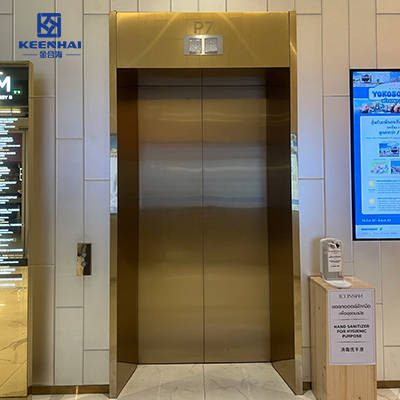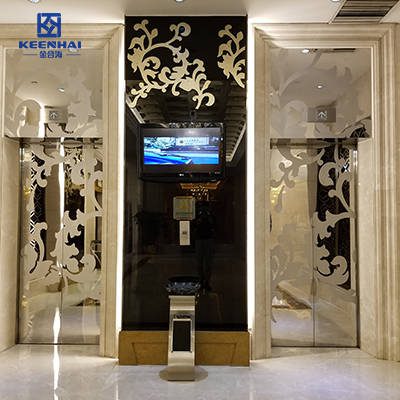1. Preparing for Stainless Steel Elevator Door Installation
1.1 Measuring Shaft and Opening Dimensions
Accurate measurements are the foundation of a smooth installation. Begin by measuring the width, height, and depth of the elevator shaft, making sure to account for any structural offsets or obstructions. For example, in high-rise commercial buildings, small deviations of even 5mm can cause misalignment of the panels, resulting in operational issues. Use a laser distance measurer or a calibrated tape for precision.
Always double-check measurements at multiple points along the shaft. This ensures that when you install the stainless steel elevator door panels, they fit perfectly without forcing adjustments. In residential projects, like luxury homes, accurate shaft sizing is crucial to ensure smooth integration with pre-existing architectural designs.
1.2 Checking Structural Support and Frame Alignment
Before installation, verify that the supporting structure can handle the door weight and operational stress. Stainless steel elevator doors can range from 200 to 600 lbs for a typical residential unit, and commercial models can weigh significantly more. Inspect the frame for level, plumb, and square alignment.
If the elevator frame is misaligned, panels may stick or fail to synchronize, leading to costly adjustments. In many cases, a simple shim or reinforcement can correct minor deviations. For modular or customized units, such as 不锈钢住宅电梯门, check whether additional anchor points are needed to support heavier finishes like mirror-polished or PVD-coated panels.
1.3 Gathering Tools and Materials
Having all necessary tools and components ready reduces delays. Essential items include:
-
Level and plumb line
-
Drill and screwdriver set
-
Laser measurer and tape
-
Shim plates and anchors
-
Safety gear (gloves, goggles, hard hats)
In addition, make sure you have all hardware that comes with the door: rollers, tracks, motors (for automatic doors), and any decorative trim. For complex projects involving 不锈钢电梯门Revit models, ensure the provided CAD files or assembly guides are on hand. Preparing materials in advance allows for a seamless workflow and prevents on-site improvisation that can compromise alignment or finish quality.

2. Installing the Door Frame and Rails
2.1 Securing the Main Door Frame
The door frame is the backbone of your elevator installation. Begin by positioning the main stainless steel elevator door frame inside the shaft opening, ensuring it sits evenly on the floor and aligns with your previous shaft measurements.
Steps to secure the frame:
-
Place shims under the bottom corners to level the frame precisely.
-
Drill pilot holes into the structural wall or floor to avoid misalignment during anchoring.
-
Use heavy-duty anchors or bolts rated for the door weight, particularly for commercial-grade doors that can exceed 600 lbs.
-
Double-check that all corners are plumb and square before fully tightening the bolts.
In multi-story buildings, verify that the frame lines up with elevator cab openings on each floor. Misalignment here can cause operational friction and increase long-term maintenance costs.
2.2 Installing Guide Rails and Tracks
Proper guide rail and track installation is critical for smooth door movement. Guide rails control vertical motion, while tracks manage the horizontal slide of the panels. Precision is everything; even a 2mm deviation can cause the doors to stick or jam.
Installation sequence:
-
Attach guide rails to the structural frame using level and laser alignment.
-
Mount horizontal tracks at the top and bottom of the door frame.
-
Insert rollers or carriers according to manufacturer specifications.
-
Test slide each panel by hand to ensure smooth operation before securing bolts completely.
For customized models, like 不锈钢电梯入口, check if additional track supports or heavier-duty rollers are needed for larger door panels or PVD-finished surfaces. Using the correct hardware prevents excessive wear and ensures consistent opening speed.
2.3 Verifying Level and Alignment
Level and alignment checks are not optional—they prevent costly adjustments later. After installing the frame and rails:
-
Use a laser level to confirm vertical alignment of both side rails.
-
Check horizontal alignment at top and bottom tracks to prevent panel binding.
-
Adjust shims and fasteners until every measurement matches within 1–2mm tolerance.
-
Re-test door movement; it should glide effortlessly without resistance.
Scenario Insight: In hotels or luxury apartments, installers often encounter misaligned shafts due to prior construction variances. Correcting these early avoids uneven wear on the rollers and maintains the premium finish of the stainless steel panels.

3. Mounting Door Panels and Mechanisms
3.1 Hanging Single-Slide or Center-Opening Panels
Proper panel mounting ensures smooth operation and longevity. Start by identifying whether your elevator uses single-slide or center-opening panels. The procedure differs slightly:
Steps for panel installation:
-
Lift the panel carefully using a hoist or team of 2–3 installers depending on door weight (commercial doors can exceed 500 lbs).
-
Align the top rollers with the pre-installed track, ensuring the panel sits flush against the guide rails.
-
Slide the panel slowly to check for proper engagement and to prevent scratching the finish.
-
Adjust the bottom guide or shim plates to ensure panels remain plumb and do not tilt during movement.
In high-traffic buildings, misaligned panels cause excessive wear. Always double-check panel height and lateral alignment before locking bolts. For residential-grade doors, like 不锈钢住宅电梯门, panels are lighter but require the same precision to avoid rattling or uneven closure.
3.2 Installing Rollers, Motors, and Synchronization Systems
The mechanical components are the heart of your automatic elevator system. Incorrect installation here can result in jerky movement, uneven opening, or premature failure.
Installation workflow:
-
Mount rollers to both top and bottom panels according to manufacturer torque specifications.
-
Secure the drive motor to the frame, ensuring proper alignment with the main drive gear.
-
Connect the motor to the synchronization system if handling center-opening doors, which ensures both panels move at equal speed.
-
Test manual operation first to confirm rollers glide without resistance.
-
Adjust tension on belts or chains as needed for smooth and silent operation.
In hotels, high-use doors demand high-duty motors and premium rollers. Upgrading to corrosion-resistant rollers or PVD-coated panels reduces long-term maintenance and maintains aesthetic quality.
3.3 Connecting Electrical Components for Automatic Doors
Electrical wiring and control installation must be precise. Faulty connections can disable the door or create safety hazards.
Steps for electrical setup:
-
Mount the control panel in an accessible but protected location within the shaft.
-
Connect the motor and sensor wiring following manufacturer schematics, labeling each wire for troubleshooting.
-
Install safety sensors at the top and bottom openings to prevent panel collisions with passengers or objects.
-
Test the automatic door cycle multiple times, monitoring speed, force, and sensor response.
-
Calibrate the system according to building codes and operational requirements.
For advanced installations, like stainless steel elevator door panels with PVD finish, check sensor placement carefully to avoid scratches or marks on the surface.

4. Finishing and Adjustments
4.1 Aligning Doors for Smooth Operation
Ensuring the doors move perfectly is crucial for both safety and appearance. Start by checking that the panels are plumb and level along the guide rails.
Steps for alignment:
-
Close the doors slowly and observe if the gap between panels is uniform from top to bottom.
-
Adjust the top rollers or bottom guide shims in small increments until the movement is smooth without scraping.
-
Test multiple cycles to ensure the door remains aligned under full weight.
-
Tighten all locking bolts gradually, rechecking alignment after each adjustment.
In many commercial installations, slight misalignment can create noise or uneven wear. For stainless steel elevator door panels with a brushed or mirror finish, proper alignment preserves both functionality and aesthetics.
4.2 Installing Decorative Panels or Handles
Adding decorative finishes improves the look while keeping doors functional. Depending on the design, panels may be PVD-coated, brushed, or mirror-polished.
Installation steps:
-
Position decorative panels and ensure they align with the existing frame and edges.
-
Secure panels using manufacturer-recommended screws or clips, avoiding over-tightening to prevent dents.
-
Attach handles or push plates, checking that they are level and centered on the door.
-
Confirm that added components do not interfere with the door’s glide or synchronization.
For residential projects, such as 不锈钢住宅电梯门, handles and finishes are usually lighter, but precision installation is still key to avoid rattling or misalignment.
4.3 Testing Open/Close Functions and Safety Sensors
Proper testing ensures the automatic system works reliably and safely.
Steps for testing:
-
Cycle the doors several times at normal speed, observing panel movement, noise, and response to control inputs.
-
Check all safety sensors, including top, bottom, and side detectors, to confirm they stop or reverse the door if blocked.
-
Verify that the synchronization system maintains equal speed on center-opening doors.
-
Make final minor adjustments to motor speed or roller tension as necessary to ensure smooth, silent operation.
-
Document all final settings for future maintenance reference.
After these steps, the elevator door should operate quietly, align perfectly, and meet both aesthetic and functional standards.

5. Maintenance Tips During Installation
5.1 Protecting Stainless Steel Surfaces from Scratches
Preventing scratches during installation preserves the finish and appearance. Start by keeping protective films on panels until final adjustments are complete. Use soft cloths or felt pads when handling doors, especially for stainless steel elevator door panels with mirror or brushed finishes. Avoid placing tools or hardware directly on the surface. In commercial projects, workers often wrap panels with foam or cardboard during movement to prevent accidental dents.
5.2 Temporary Support and Adjustment Recommendations
Proper temporary support ensures alignment and prevents stress on hardware.
Steps for temporary support:
-
Use adjustable braces or shims to hold the frame level before permanent fastening.
-
Check the vertical and horizontal alignment periodically as panels are hung.
-
Avoid over-tightening temporary supports, which can distort the frame or misalign guide rails.
-
Keep a clear record of adjustments made, so final installation can replicate precise measurements.
This is especially important for 不锈钢住宅电梯门, where lighter panels may shift easily without proper temporary support.
5.3 Ensuring Longevity of Hardware and Mechanisms
Proper handling during installation extends the lifespan of rollers, motors, and synchronization systems.
-
Lubricate guide rails lightly according to manufacturer guidelines before full operation.
-
Check all fasteners and tighten incrementally to avoid warping frames or misaligning doors.
-
Test each component under load before removing temporary supports to ensure smooth operation.
-
Schedule follow-up inspections after initial operation to confirm mechanisms remain aligned and functional.
Following these steps protects both the finish and the performance of your elevator doors. For professional-grade stainless steel elevator systems and comprehensive solutions, you can naturally explore more at pvdstainlesssteel for installation guides, product specifications, and long-term support.






